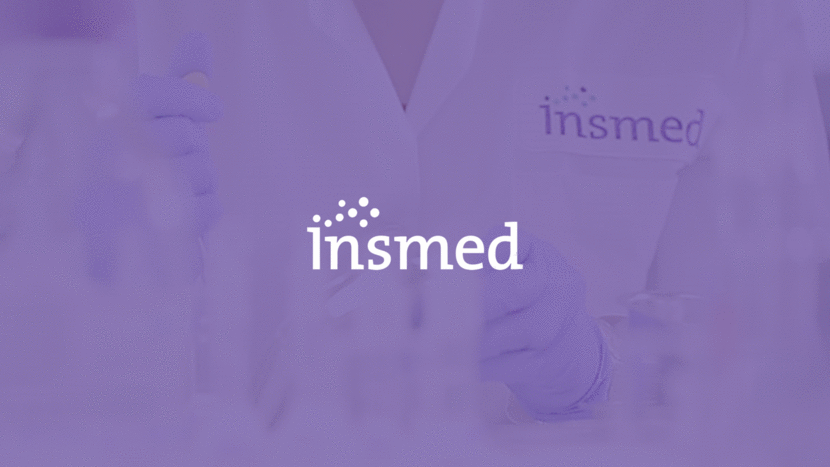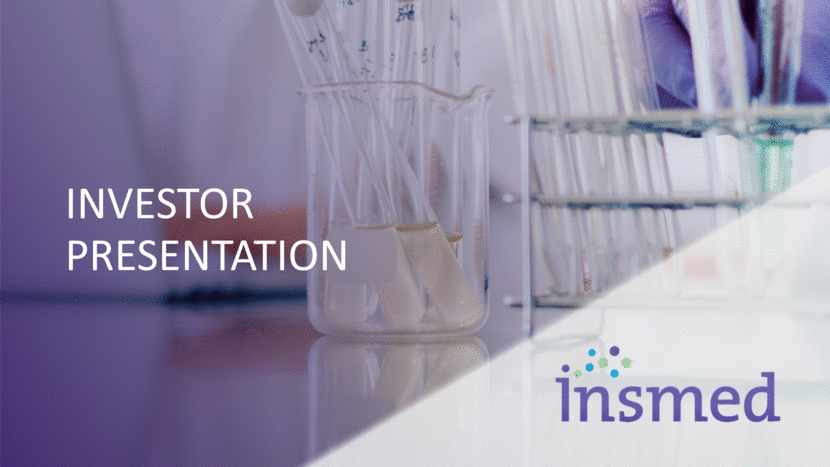Attached files
| file | filename |
|---|---|
| 8-K - 8-K - INSMED Inc | a18-6034_18k.htm |
Safe Harbor Statement 2 This presentation contains forward looking statements. "Forward-looking statements," as that term is defined in the Private Securities Litigation Reform Act of 1995, are statements that are not historical facts and involve a number of risks and uncertainties. Words herein such as "may," "will," "should," "could," "would," "expects," "plans," "anticipates," "believes," "estimates," "projects," "predicts," "intends," "potential," "continues," and similar expressions (as well as other words or expressions referencing future events, conditions or circumstances) may identify forward-looking statements. The forward-looking statements in this presentation are based upon the Company’s current expectations and beliefs, and involve known and unknown risks, uncertainties and other factors, which may cause the Company’s actual results, performance and achievements and the timing of certain events to differ materially from the results, performance, achievements or timing discussed, projected, anticipated or indicated in any forward-looking statements. Such factors include, among others: risks that the full six-month data from the CONVERT study or subsequent data from the remainder of the study’s treatment and off-treatment phases will not be consistent with the top-line six-month results of the study; uncertainties in the research and development of our existing product candidates, including due to delays in data readouts, such as the full data from the CONVERT study, patient enrollment and retention or failure of our preclinical studies or clinical trials to satisfy pre-established endpoints, including secondary endpoints in the CONVERT study and endpoints in the INS-312 study; lack of safety and efficacy of our product candidates; failure to develop, or to license for development, additional product candidates, including a failure to attract experienced third-party collaborators; failure to obtain, or delays in obtaining, regulatory approval from the United States Food and Drug Administration, Japan’s Ministry of Health, Labour and Welfare, the European Medicines Agency, and other regulatory authorities for our product candidates or their delivery devices, including due to insufficient clinical data or selection of endpoints that are not satisfactory to regulators, complexity in the review process for combination products or inadequate or delayed data from a human factors study required for US regulatory approval; lack of experience in conducting and managing preclinical development activities and clinical trials necessary for regulatory approval, including the regulatory filing and review process; failure of third parties on which we are dependent to conduct our clinical trials, to manufacture sufficient quantities of our product candidates for clinical or commercial needs, or to comply with our agreements or laws and regulations that impact our business; failure to comply with license agreements that are critical for our product development, including our license agreements with PARI Pharma GmbH and AstraZeneca AB; inaccuracies in our estimate of the size of the potential markets for our product candidates; failure to maintain regulatory approval for our product candidates, if received, due to a failure to satisfy post-approval regulatory requirements, such as the submission of sufficient data from confirmatory clinical trials; uncertainties in the rate and degree of market acceptance of product candidates, if approved; uncertainties in the timing, scope and rate of reimbursement for our product candidates; competitive developments affecting our product candidates; inaccurate estimates regarding our future capital requirements, including those necessary to fund our ongoing clinical development, regulatory and commercialization efforts as well as milestone payments or royalties owed to third parties; inability to repay our existing indebtedness or to obtain additional financing when needed; failure to obtain, protect and enforce our patents and other intellectual property; inability to create an effective direct sales and marketing infrastructure or to partner with third parties that offer such an infrastructure for distribution of our product candidates, if approved; the cost and potential reputational damage resulting from litigation to which we are a party, including, without limitation, the class action lawsuit pending against us; failure to comply with the laws and regulations that impact our business; loss of key personnel; and changes in laws and regulations applicable to our business, including those related to pricing and reimbursement of our product candidates. For additional information about the risks and uncertainties that may affect our business, please see the factors discussed in Item 1A, "Risk Factors,“ in the Company's Quarterly Report on Form 10-Q for the three months ended September 30, 2017 and any subsequent filings with the Securities and Exchange Commission. The Company cautions readers not to place undue reliance on any such forward-looking statements, which speak only as of the date of this presentation. The Company disclaims any obligation, except as specifically required by law and the rules of the Securities and Exchange Commission, to publicly update or revise any such statements to reflect any change in expectations or in events, conditions or circumstances on which any such statements may be based, or that may affect the likelihood that actual results will differ from those set forth in the forward-looking statements. This presentation includes information related to market opportunity as well as cost and other estimates obtained from various internal analyses and calculations and external sources, including publicly available information, market research and data from a variety of claims databases. The externally sourced information has been obtained from sources we believe to be reliable, but we cannot assure the accuracy and completeness of such information. Similarly, our internal analyses and calculations are based upon management’s understanding of market and industry conditions and has not been verified by independent sources. Forward-looking information presented from each of these sources is subject to the same qualifications and uncertainties as the other forward-looking statements in this presentation.
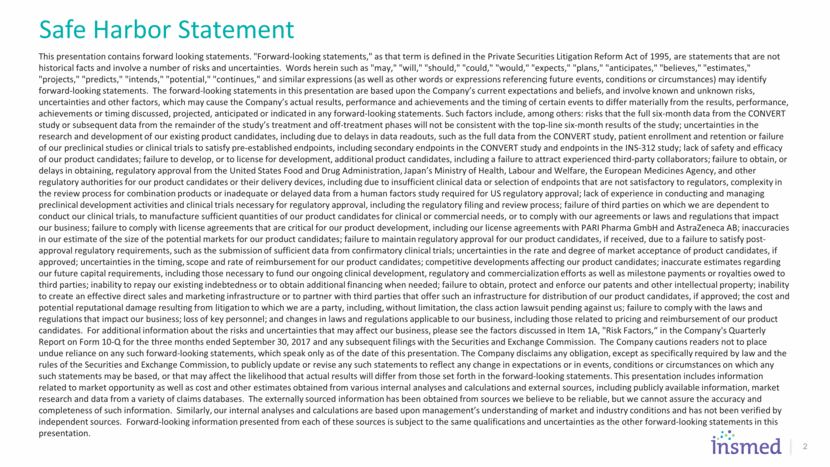
3 To transform the lives of patients battling serious rare diseases OUR MISSION
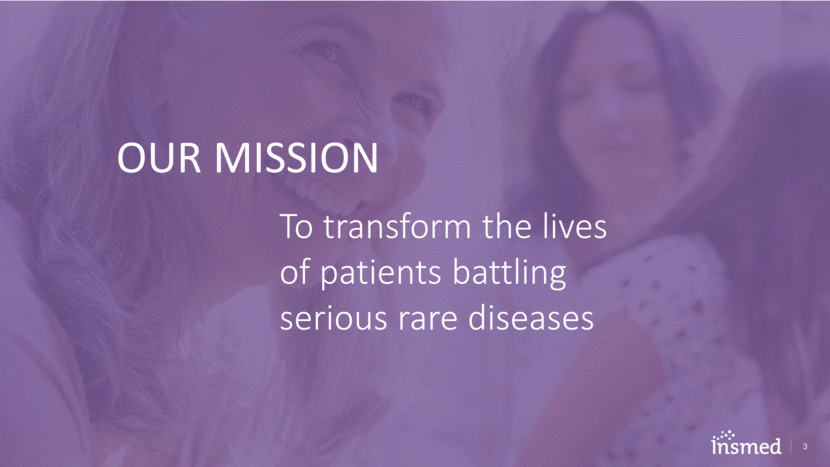
Insmed: A Global Biopharmaceutical Company Focused on Rare Disease 4 POSITIVE TOP-LINE PHASE 3 RESULTS FOR ALIS GLOBAL COMMERCIAL OPPORTUNITY ALIS LIFE CYCLE MANAGEMENT GROWING PIPELINE
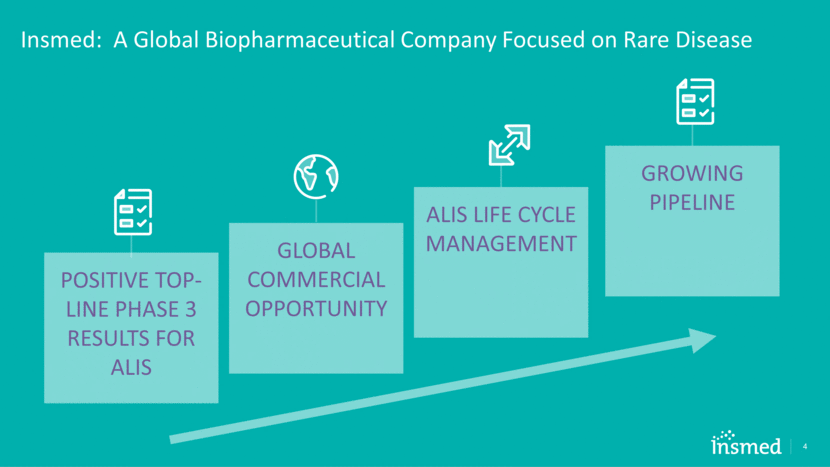
Treatment of NTM lung disease represents significant unmet need Current antibiotic regimens are inadequate in treating NTM disease, with no known approved therapies in US and EU 5 1 2 3 4 5 Declining lung function Globally prevalent and growing at approximately 8% annually in the US Up to 33% mortality rate for patients with NTM caused by MAC within 5 years of diagnosis Significant economic burden
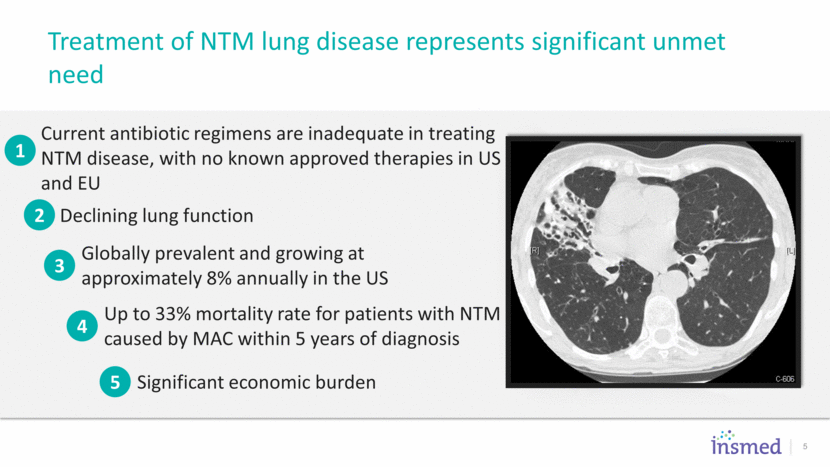
Estimated 2018 US Market Opportunity in NTM 6 REFRACTORY NTM CAUSED BY MAC 10K - 15K NTM CAUSED BY MAC 60K - 85K DIAGNOSED NTM 75K - 105K
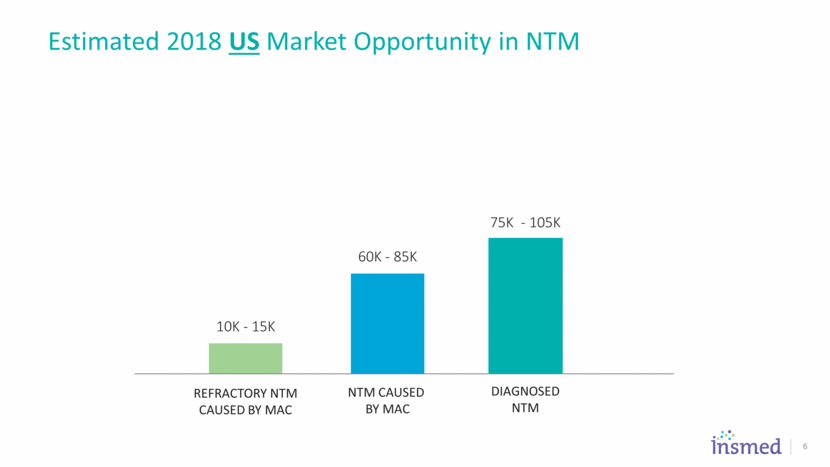
Global Opportunity – Near-Term Focus on US, Japan and EU 7 *Source: Internal analysis of published NTM epidemiology, primary market research with treating HCPs, and anonymized patient level claims data in US † EU5 comprised of France, Germany, Italy, Spain and the United Kingdom 125K – 145K total diagnosed NTM patients (2018E)* 15K - 18K total refractory MAC patients (2018E)* Japan ~14K total diagnosed NTM patients (2018E)* ~1,400 total refractory MAC patients (2018E)* EU5† 75K - 105K total diagnosed NTM patients (2018E)* 10K - 15K total refractory MAC patients (2018E)* US
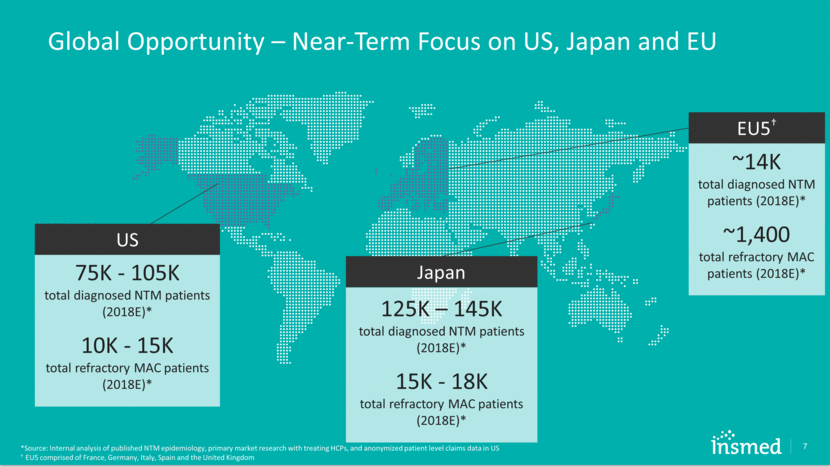
Science of ALIS/Our Solution 8 Combination of Free and Liposomal Amikacin Scintigraphy Demonstrates Diffuse Pulmonary Distribution Tested across 5 strains of MAC in vitro ALIS More Effective than Amikacin In Vitro Uptake in the Lung Macrophage Tested Across 5 Strains of NTM
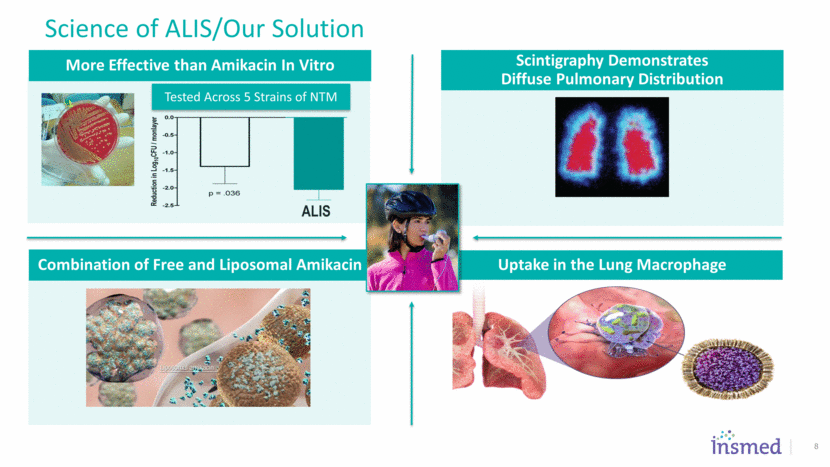
ALIS once daily + Guideline Based Therapy 9 Adult Patients with NTM (MAC) Lung Disease Failing at least 6 months of a multi-drug regimen KEY INCLUSION CRITERIA Guideline Based Therapy R Screening period Month-6 sputum culture PRIMARY ENDPOINT Culture Conversion at 6 months INS-212 non-converters INS-312 ALIS once daily + Guideline Based Therapy Guideline Based Therapy Baseline through Month 6 Up to Month 16 12 months off all treatment Full Approval Endpoint 3 Months Off All Treatment INS-212
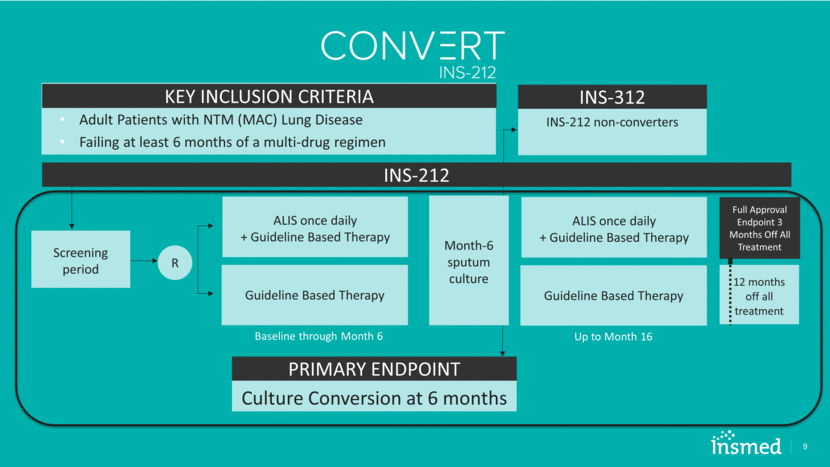
Top-line Data Indicates CONVERT Study Met Primary Endpoint* Addition of ALIS to GBT** eliminated evidence in sputum of NTM lung disease caused by MAC by Month 6 in 29% of patients, compared to 9% of patients on GBT alone (p <0.0001) 20% absolute difference in treatment groups in favor of ALIS arm 10 p <0.0001 Percentage of Patients with Negative NTM Sputum Culture BY Month 6 (3 Consecutive Negative Sputum Cultures) * Top-line data released September 2017 **Guideline Based Therapy 29% 9% ALIS + GBT GBT

Top-line CONVERT Study Results – Secondary Endpoints at Month 6 11 Time to Conversion Patients in the GBT-only arm took approximately 30% longer to convert when compared to patients on ALIS plus GBT (p<0.0001) 6-Minute Walk Distance (6MWD) No statistically significant difference between patients in the two arms Analysis per a pre-specified endpoint shows that patients who achieved culture conversion across both arms demonstrated an improvement in 6-minute walk distance vs. patients who did not culture convert (p=0.0108)
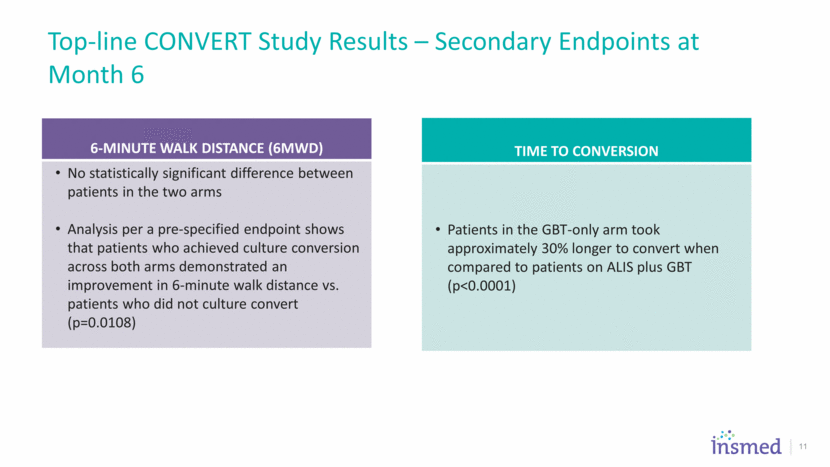
Top-Line CONVERT Safety Summary Adverse events, consistent with those seen with use of inhaled antibiotics, more frequent in ALIS + GBT arm Serious treatment emergent adverse events were similar between treatment arms No distinctions between treatment arms of hearing loss or renal impairment 12 2:1 Randomization Serious TEAEs >3% ALIS (n=223) GBT (n=112) Patients Reporting at Least One Serious Treatment Emergent Adverse Event 20.2% (45) 17.9% (20) System Organ Class Preferred Term Respiratory, Thoracic, Mediastinal Disorders 11.7% (26) 9.8% (11) Hemoptysis 2.7% (6) 4.5% (5) COPD (exacerbation) 3.1% (7) 0.9% (1) Infections and Infestations 9.0% (20) 5.4% (6) Pneumonia 3.6% (8) 1.8% (2) Cardiac Disorders 0.4% (1) 4.5% (5) Patient Deaths 2.7% (6) 4.5% (5) Drop Outs (%) 19.6% (44) 8.9% (10) Total Drop Outs (%) 16.1% (54)
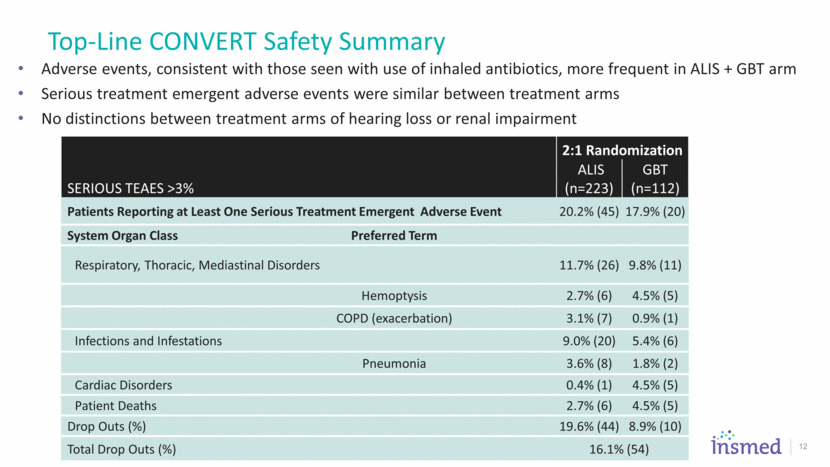
CONVERT Study Demographics Summary ALIS (n=224) GBT (n=112) Smokers 11.6% (26) 8.9% (10) Guideline Based Therapy Prior to Enrollment On Treatment 89.7% (201) 90.2% (101) Off Treatment for > 3 months 10.3% (23) 9.8% (11) Geography US 41.5% (93) 42.9% (48) Asia 21.4% (48) 17.9% (20) EU + ROW 37.1% (83) 39.3% (44) Male 26.3% (59) 39.3% (44) Female 73.7% (165) 60.7% (68) Mean Age (years) 64.6 64.9 13
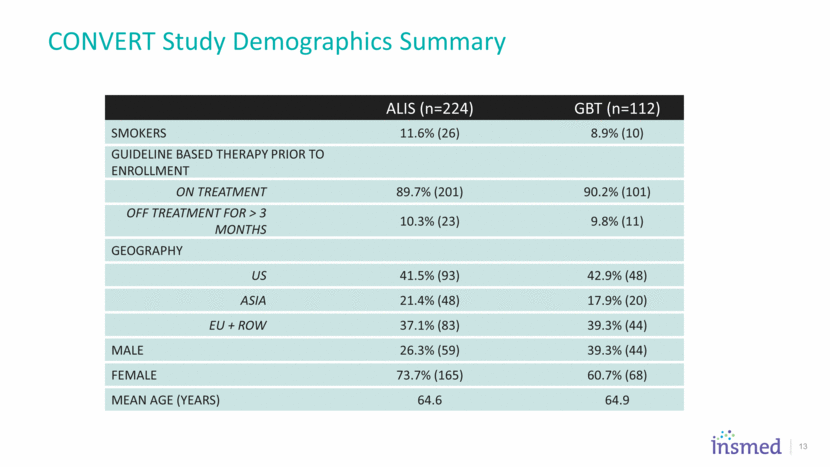
14 Additional interim top-line results from ongoing INS-212 and INS-312 studies announced January 2018
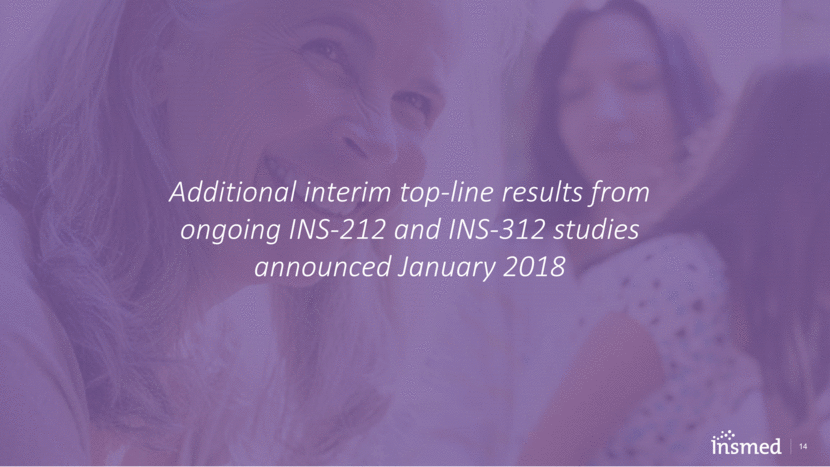
Interim Descriptive Data Show that Sputum Culture Conversion in INS-312 is Consistent with Sputum Culture Conversion in Top-Line Results from INS-212 15 Percentage of Patients with Sputum Culture CONVERSION AS OF DECEMBER 2017* (3 Consecutive Negative Sputum Cultures) 29% of patients initiating ALIS added to GBT in INS-212 achieved culture conversion by Month 6 28% of patients initiating ALIS added to GBT in the extension INS-312 study achieved culture conversion by Month 6 29% (65/224) *As of December 2017, 67 of 90 patients in the prior GBT Alone Arm in INS-212 were evaluable for Sputum Culture Conversion 28% (19/67) 0% 5% 10% 15% 20% 25% 30% 35% 40% 45% Months on Treatment ALIS + GBT Arm In INS - 212 GBT Non - Converters Crossed Over to ALIS + GBT in INS - 312 CROSSOVER TO INS - 312 AT MONTH 8 0 6 8 14

16 29% (65/224) *As of December 2017, 57 of 73 patients in the prior ALIS + GBT Arm in INS-212 were evaluable for Sputum Culture Conversion 12% of prior non-converters from INS-212 ALIS + GBT arm achieved culture conversion by Month 6 in INS-312 Interim Descriptive Data Show Continued Treatment with ALIS + GBT Results in More Patients Achieving Culture Conversion ALIS + GBT Non-Converters Continuing Treatment in INS-312 Percentage of Patients with NTM Sputum Culture CONVERSION AS OF DECEMBER 2017* (3 Consecutive Negative Sputum Cultures) 0% 5% 10% 15% 20% 25% 30% 35% 40% 45% Months on Treatment ALIS + GBT Arm in INS - 212 CROSSOVER TO INS - 312 AT MONTH 8 0 6 8 14 12% (7/57)
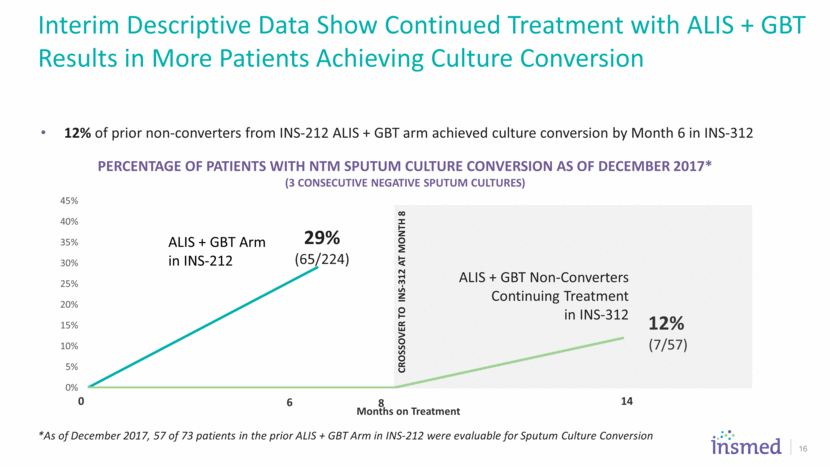
Interim Descriptive Data Show that in INS-212, Durability of Culture Conversion is Substantially Higher in ALIS + GBT Arm (61% vs. 0% as of December 2017)* 17 Percentage of Converters from each arm who remain culture negative three months off treatment ALIS + GBT shows a more durable culture conversion result than GBT alone *The company expects complete topline data to support potential full regulatory approval in late 2018 or early 2019. Durability is the percent of patients who complete the treatment cycle and remain culture negative 3 months off all therapy. 61% (28/46) 0% (0/7) 0% 20% 40% 60% 80% 100% 6-Month Endpoint 3 Months off All Treatment ALIS + GBT (46 evaluable patients) GBT (7 evaluable patients)

INS-212 and INS-312 Safety Summary No Change in Overall Safety Assessment for ALIS Based on Interim Data INS-212 Adverse events, consistent with those seen with use of inhaled antibiotics, more frequent in ALIS + GBT arm Serious treatment emergent adverse events were similar between treatment arms No distinctions between treatment arms of hearing loss or renal impairment As of December 2017, the overall drop out rate is 18% INS-312 Serious treatment emergent adverse events similar to those in INS-212 As of December 2017, the drop out rate is 24% 18
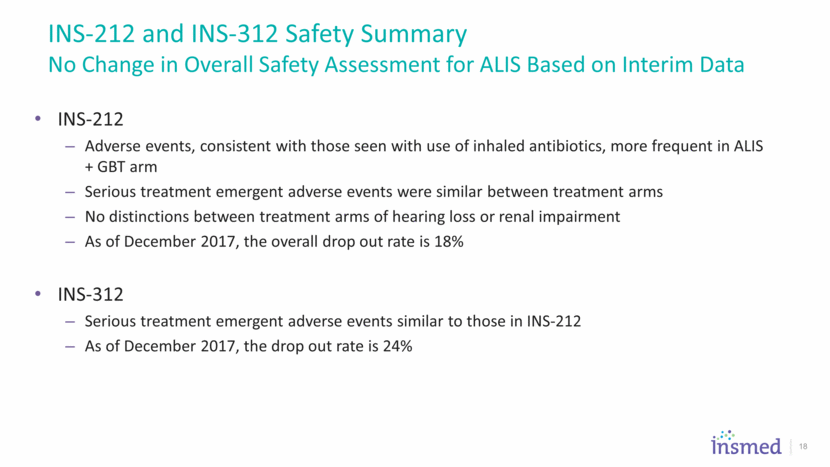
NDA Submission planned based on primary endpoint under Subpart H Pathway to US Submission – Division of Anti-Infective Products 19 Breakthrough Designation Orphan and QIDP Accelerated Approval Full Approval Requirement 12 years of exclusivity (7 orphan and 5 QIDP) and anticipates priority review Guidance on efficient drug development; allows for rolling submission Confirmatory endpoint contained within study design
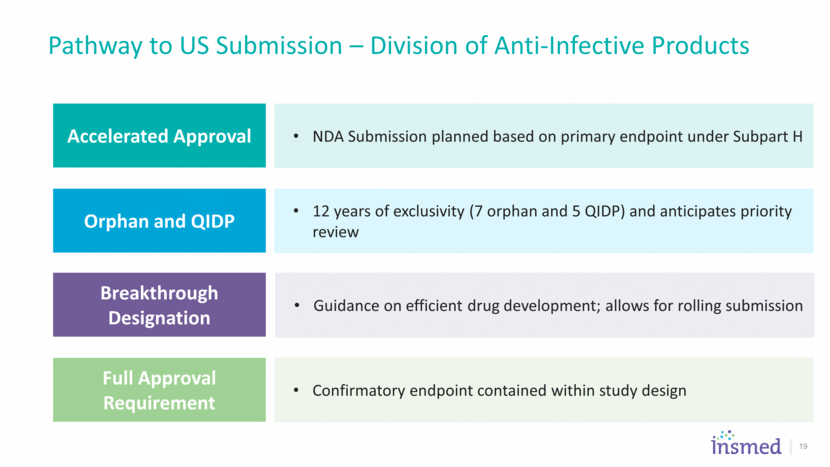
72 Therapeutic Specialists Expected to Cover the US Market Based on Concentration of NTM Treatment Among Providers 20 Source: Symphony Health, PatientSourceTM November 2013 – October 2016 ~5K physicians manage 70% of diagnosed NTM patients 8 in 10 diagnosed NTM patients managed by Pulmonologist or Infectious Disease Specialist Cumulative % of Patients Attributed Cumulative % of Physicians ~2.1K HCPs account for ~50% of potential ~3K HCPs account for ~20% of potential ~11.5K HCPs account for ~30% of potential patients

Actively Educating the Community About NTM 21 “1,000 Words about NTM” “Over & Over” Healthcare Professional Disease Awareness Campaign NTMFacts.com Patient Disease Awareness Campaign AboutNTM.com
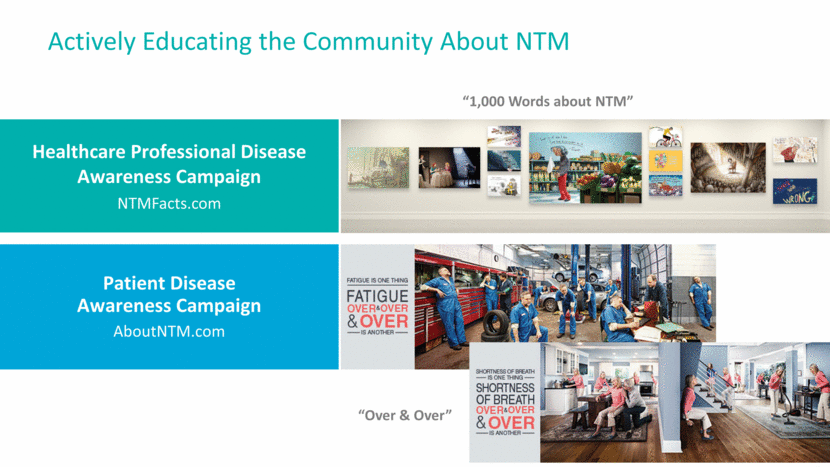
NTMLD COPD IPF PAH Lung Cancer $48,169 $22,901 $44,313 $51,753 $69,005 *First year insurance spending was summarized from a national managed care claims database following the first diagnosis of each disease between 2007 and 2016 and standardized using RBRVS (Resource Based Relative Value Scale) by such database. Estimated average insurance spending was determined based on internal analysis of the summarized data. Calculation is subject to sample fluctuation due to small patient numbers in subgroups. PAH = pulmonary arterial hypertension, IPF = Idiopathic pulmonary fibrosis Estimated Average First-Year Insurance Spending in NTMLD and Patient Groups of COPD, IPF, PAH, and Lung Cancer without NTMLD* 22

¹ Based on Wholesale Acquisition Cost (WAC). Source: Redbook (7/7/17) ² IPF and PAH patients frequently require use of multiple agents making annual costs significantly higher ³ Cystic Fibrosis agents’ WAC represents 6 months of therapy due to every other month dosing Cystic Fibrosis ³ 30,000 patients IPF ² 132,000 patients PAH ² 47,000 patients Estimated Annual Cost of Leading Respiratory Orphan Drugs¹ 23 Tobi Podhaler (6 months) $57,377 Cayston (6 months) $51,262 OFEV $103,680 Esbriet $102,211 Opsumit $99,504 Letairis $111,055 Uptravi $181,212 Tyvaso $201,000 $ - $50,000 $100,000 $150,000 $200,000 $250,000
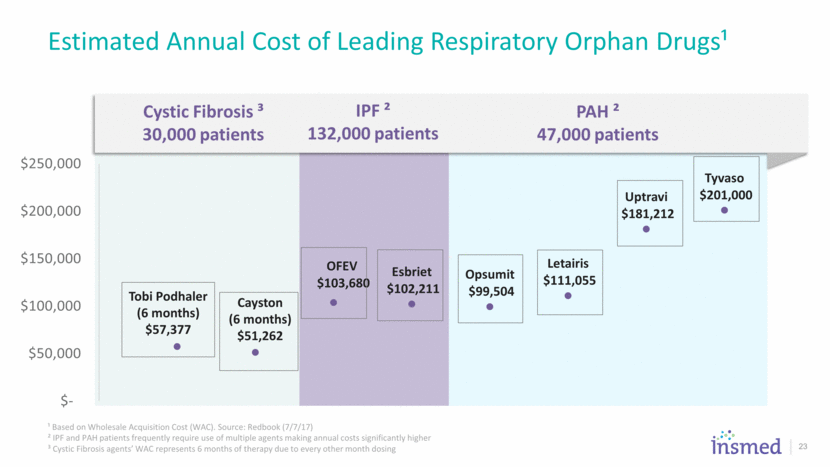
ALIS Value Proposition – Treatment Reduces Cost Pulmonary Nontuberculous Mycobacterial Infections: Healthcare Resource Utilization and Costs in Medicare Patients at a US Health Plan. Abraham et al. Methods: Medical and pharmacy claims between January 1, 2007, and May 31, 2014, were used to identify Medicare patients with NTMPD infection (n = 738) and matched controls (n = 5166). Patients with NTMPD infection were further subdivided in 2 groups: Guideline Optimal Treatment (n=214) and Suboptimal Treatment. Poster presented at the Academy of Managed Care Pharmacy (AMCP) Nexus 2015 Conference 24 ER VISITS TOTAL COSTS HOSPITAL ADMISSIONS 7X 5X 3X Increased costs for NTM patients vs. age-matched controls (monthly) Costs are reduced when NTM is treated (monthly) DURATION OF HOSPITAL STAY ~2 Extra Days/Month - 53% - 39% - 29% - 11%
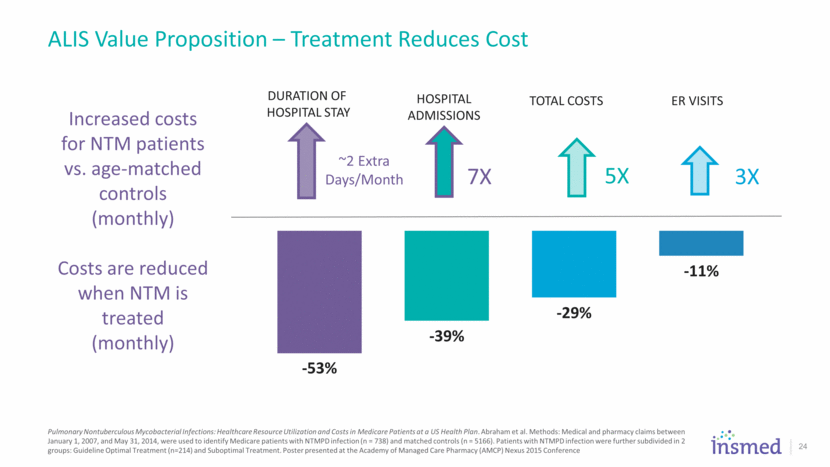
Established Supply Chain Redundant drug supply chain Commercial-scale manufacturing capacity on-line 25 50L 200L Patheon* (part of Thermo Fisher Scientific) 450L Patheon long term project initiated 4Q 2017
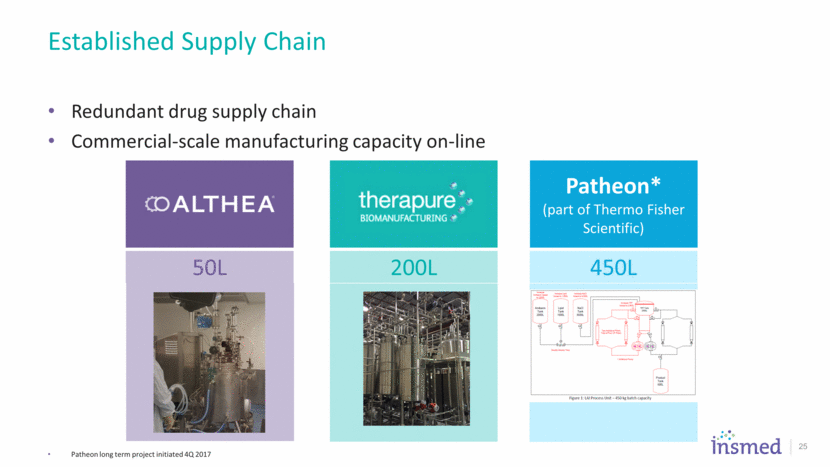
Potential to extend exclusivity to May 2033 with system claims Japanese patent portfolio 2033 2027 2030 2028 2029 2026 ALIS: Multiple Layers of Market Exclusivity 26 US patent portfolio Coverage into Jan. 2034 Potential 6-month pediatric extension US: 12-year exclusivity (orphan and QIDP designations) Potential pediatric extension (6-month) Regulatory exclusivity periods (US/EU) EU: 10-year exclusivity (orphan designation) Potential pediatric extension (2-year) 2031 2032 2034
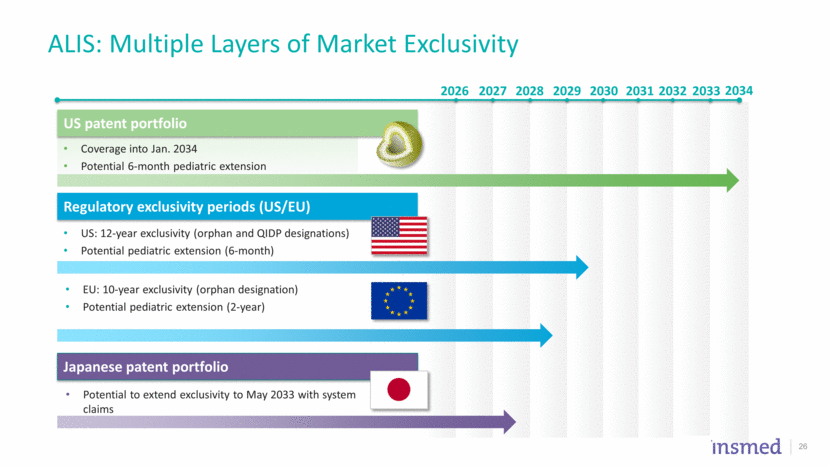
PRECLINICAL PHASE 1 PHASE 2 PHASE 3 ARIKAYCE®: Amikacin Liposome Inhalation Suspension (ALIS) Refractory NTM: M. avium complex (MAC) ARIKAYCE®: Amikacin Liposome Inhalation Suspension (ALIS) Front line, maintenance, other non MAC NTM species, e.g. M Abcessus INS1007: DPP1 Inhibitor Non-CF bronchiectasis INS1009: Inhaled Prostanoid Pulmonary Arterial Hypertension (PAH) Internal R&D Various indications Corporate Development Growing Pipeline 27 Life Cycle Management CONVERT Study
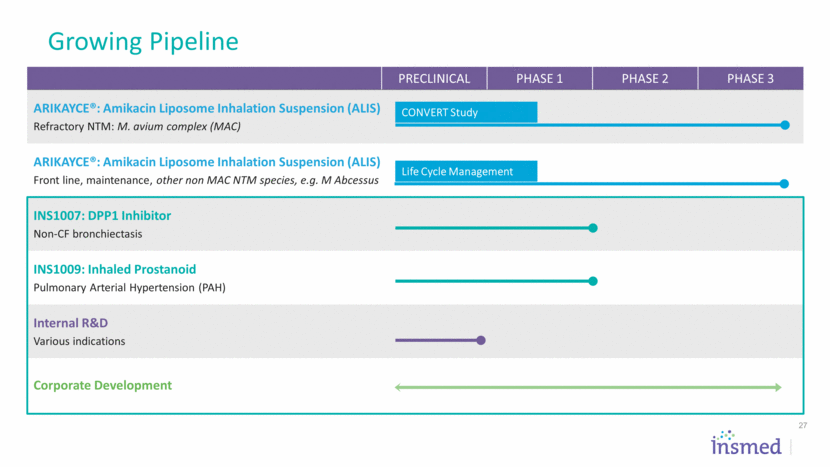
2018 Financial Guidance – 1st Half 28 ALIS Commercial Activities: Hire and deploy: Therapeutic Specialists, Patient Services and Key Account Directors Continue to invest in physician and patient disease awareness campaigns Advance Japan/global expansion ALIS Manufacturing Investments: Continue buildout of 3rd-party manufacturing site Build inventory for launch R&D / G&A ALIS Life-Cycle Management Opportunities INS 1007 / 1009 G&A / Infrastructure Total cash needs for 1H/ 2018* $145 million to $165 million * Key milestones will gate spending throughout the year. Excludes potential debt repayment.
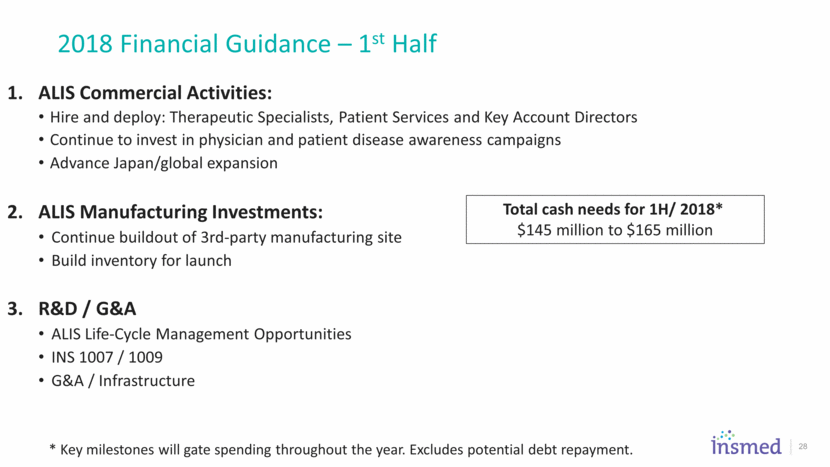
Insmed: A Global Biopharmaceutical Company Focused on Rare Disease 29 POSITIVE TOP-LINE PHASE 3 RESULTS FOR ALIS GLOBAL COMMERCIAL OPPORTUNITY ALIS LIFE CYCLE MANAGEMENT GROWING PIPELINE
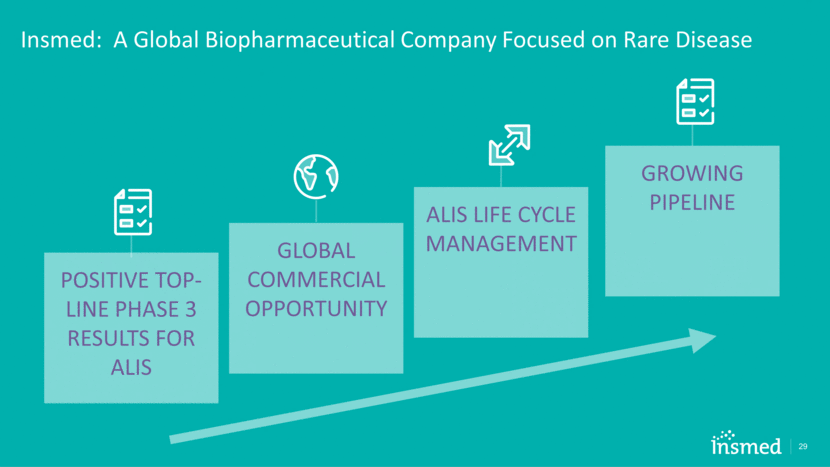
[LOGO]
